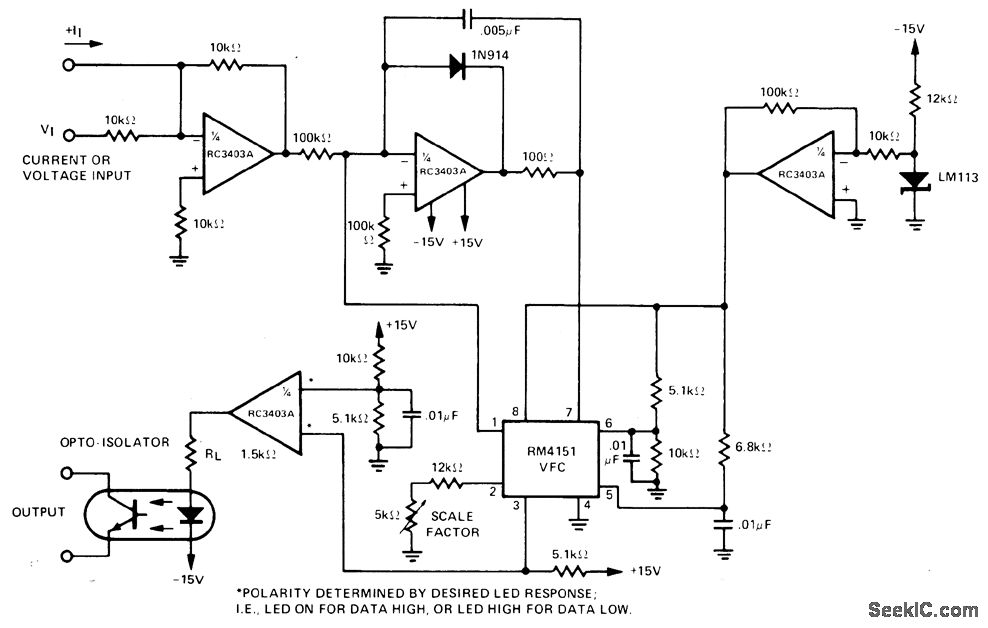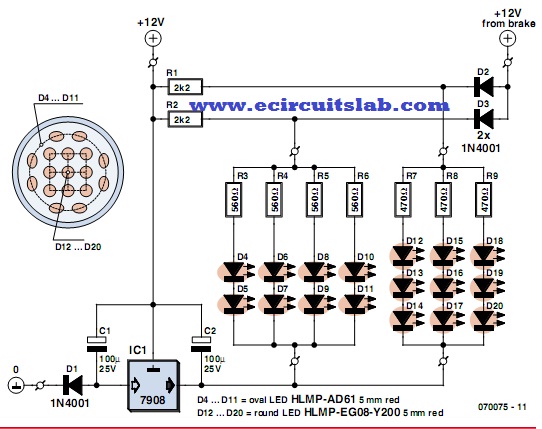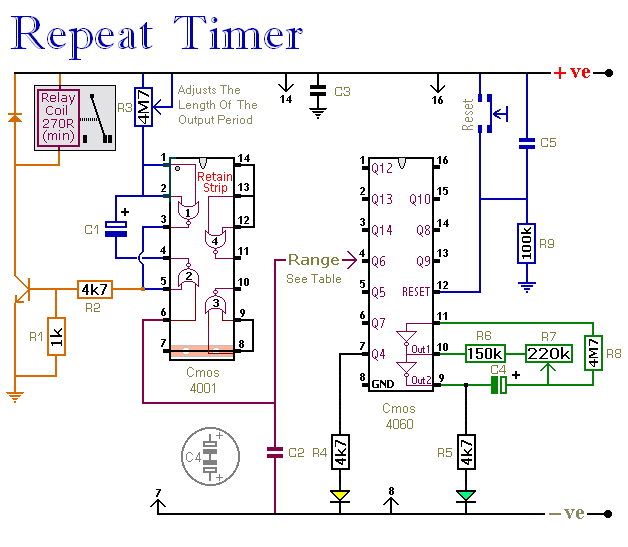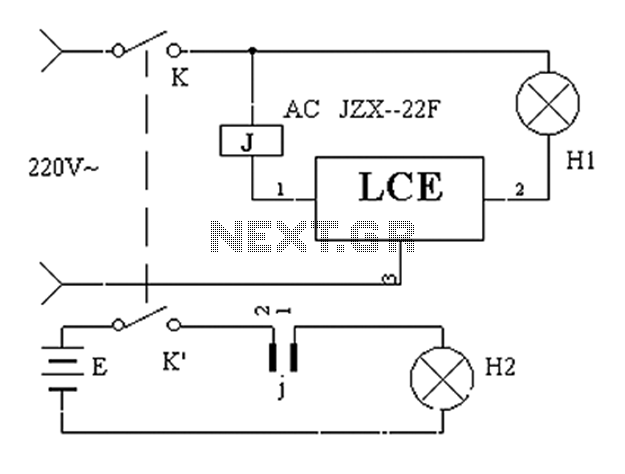
Call Acknowledged !
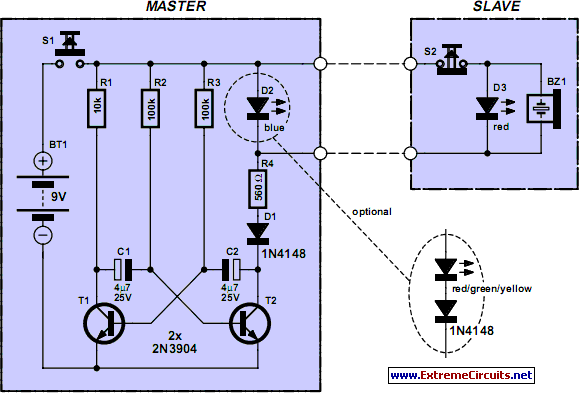
This circuit can be utilized by individuals, such as a gentleman summoning his butler, a manager calling for his secretary, or a parent calling children to dinner without needing to raise their voice over the noise of a CD player, television, or gaming console. Instead of implementing a full intercom system, a simpler solution has been proposed. While a buzzer could suffice for this purpose, this circuit offers the added benefit of providing a visual indication of a call and confirming to the caller that their message has been received. This feature is particularly important as the call may be easily drowned out by music from headphones. The circuit requires no complicated switching and operates using a simple two-wire connection between the two stations. It takes advantage of the fact that the forward voltage drop of a blue or white LED is higher than that of red, green, or yellow LEDs. The design is based on a two-transistor multivibrator that pulses a red LED (D3) and a buzzer (Bz1) on and off at approximately 1.5 Hz when the push button (S1) is pressed. This frequency can be modified by changing the capacitor values. Diode D1, connected in series with the collector of transistor T2, isolates the output from the buzzer circuitry to prevent alterations in the multivibrator frequency. Although the multivibrator could be omitted, a pulsed buzzer and flashing LED are more noticeable than a continuous signal, especially in noisy environments. The voltage across a red LED is typically around 1.5 V, while a blue LED requires 2.5 V to 3 V to illuminate, which means the blue LED will remain off when the call button (S1) is activated. Most piezo sounders, rated for operation at 3-12 V, can still produce a loud sound from the pulsed 1.5 V available across the red LED, effectively catching the attention of even the most distracted teenager. When the recipient presses the acknowledgment switch (S2), the red LED and buzzer are disconnected, allowing the blue LED to flash at the sending station, indicating to the caller that their call has been acknowledged. Alternatively, if a blue LED is not available, a red or green LED can be used in series with a forward-biased silicon diode to raise its forward voltage above that of the red LED in the receiver. The circuit can be powered by a 9 V battery, making a mains power supply unnecessary due to the low power consumption and infrequent use of the circuit.
This circuit is designed for effective communication in environments where noise levels are high, and it employs a straightforward yet efficient method to notify individuals of incoming calls. The use of a two-transistor multivibrator allows for the generation of a pulsed signal, which is crucial for ensuring that alerts are noticeable amid ambient noise. The selection of components is based on their voltage characteristics, optimizing the performance of the LEDs and buzzer. The red LED acts as a visual alert for the sender, while the buzzer provides an auditory signal, making it suitable for various applications, including home and office settings.
The simplicity of the two-wire connection enhances the circuit's versatility, allowing for easy installation without the need for complex wiring or additional infrastructure. The acknowledgment feature, facilitated by switch S2, provides feedback to the caller, ensuring that communication is clear and effective. The option to substitute the blue LED with other colors, combined with the diode to adjust voltage levels, enhances the circuit's adaptability to different user preferences and component availability.
Overall, this circuit is a practical solution for discreet communication, combining visual and auditory alerts to ensure that messages are conveyed and acknowledged efficiently. Its low power requirements and ease of use make it an ideal choice for domestic and professional environments where traditional intercom systems may be impractical.This circuit could be used (depending on your circumstances) by a gentleman to summon his butler, a manager his secretary or as in the author`s case to call the kids down to dinner without having to shout above the level of the CD player/TV/games console in their bedroom. Rather than resorting to a full-blown intercom system, a simpler solution wa s envisaged and while a buzzer could easily fulfil this function, this circuit has the advantage of providing a visual indication of a call as well as confirming to the caller that the message` has been received. This is especially useful in the latter case, as the call may be easily drowned out by the music playing in the headphones.
The circuit, which requires no complicated switching, uses a simple two-wire connection between the two stations and utilises the fact that the forward voltage drop of a blue (or white) LED is greater than that of a red, green or yellow one. The circuit is based on a two-transistor multivibrator which is used to pulse a red LED (D3) as well as the buzzer Bz1 on and off at about 1.
5 Hz when push button S1 is closed. This frequency may of course be altered if required by changing the values of the capacitors. The diode D1 in series with the collector of transistor T2 is required to isolate the output from the effects of the buzzer circuitry, which would alter the multivibrator frequency. In principle, the multivibrator could be dispensed with but a pulsed buzzer/flashing led is much more noticeable than a continuous signal especially in noisy conditions.
Since the voltage across a red LED is typically about 1. 5 V while a blue LED requires at least 2. 5 V to 3 V to light, the blue LED will remain off when the call button S1 is pressed. Despite being rated for operation at 3-12 V, most piezo sounders can still produce a piercing sound from the pulsed 1. 5-V available across the red LED which should get the attention of even the most preoccupied teenager.
When the recipient presses the acknowledge (push to break) switch S2, the red LED/buzzer are disconnected allowing the blue LED to flash at the sending station indicating to the caller that his call has been received. Alternatively, if a blue LED is not available, a red or green type in series with a forward biased silicon diode to raise its forward voltage above that of the red LED in the receiver could be used instead.
The circuit may be powered by a 9-V battery, a mains power supply being unnecessary in view of the low power consumption and infrequency of use of the circuit. 🔗 External reference
This circuit is designed for effective communication in environments where noise levels are high, and it employs a straightforward yet efficient method to notify individuals of incoming calls. The use of a two-transistor multivibrator allows for the generation of a pulsed signal, which is crucial for ensuring that alerts are noticeable amid ambient noise. The selection of components is based on their voltage characteristics, optimizing the performance of the LEDs and buzzer. The red LED acts as a visual alert for the sender, while the buzzer provides an auditory signal, making it suitable for various applications, including home and office settings.
The simplicity of the two-wire connection enhances the circuit's versatility, allowing for easy installation without the need for complex wiring or additional infrastructure. The acknowledgment feature, facilitated by switch S2, provides feedback to the caller, ensuring that communication is clear and effective. The option to substitute the blue LED with other colors, combined with the diode to adjust voltage levels, enhances the circuit's adaptability to different user preferences and component availability.
Overall, this circuit is a practical solution for discreet communication, combining visual and auditory alerts to ensure that messages are conveyed and acknowledged efficiently. Its low power requirements and ease of use make it an ideal choice for domestic and professional environments where traditional intercom systems may be impractical.This circuit could be used (depending on your circumstances) by a gentleman to summon his butler, a manager his secretary or as in the author`s case to call the kids down to dinner without having to shout above the level of the CD player/TV/games console in their bedroom. Rather than resorting to a full-blown intercom system, a simpler solution wa s envisaged and while a buzzer could easily fulfil this function, this circuit has the advantage of providing a visual indication of a call as well as confirming to the caller that the message` has been received. This is especially useful in the latter case, as the call may be easily drowned out by the music playing in the headphones.
The circuit, which requires no complicated switching, uses a simple two-wire connection between the two stations and utilises the fact that the forward voltage drop of a blue (or white) LED is greater than that of a red, green or yellow one. The circuit is based on a two-transistor multivibrator which is used to pulse a red LED (D3) as well as the buzzer Bz1 on and off at about 1.
5 Hz when push button S1 is closed. This frequency may of course be altered if required by changing the values of the capacitors. The diode D1 in series with the collector of transistor T2 is required to isolate the output from the effects of the buzzer circuitry, which would alter the multivibrator frequency. In principle, the multivibrator could be dispensed with but a pulsed buzzer/flashing led is much more noticeable than a continuous signal especially in noisy conditions.
Since the voltage across a red LED is typically about 1. 5 V while a blue LED requires at least 2. 5 V to 3 V to light, the blue LED will remain off when the call button S1 is pressed. Despite being rated for operation at 3-12 V, most piezo sounders can still produce a piercing sound from the pulsed 1. 5-V available across the red LED which should get the attention of even the most preoccupied teenager.
When the recipient presses the acknowledge (push to break) switch S2, the red LED/buzzer are disconnected allowing the blue LED to flash at the sending station indicating to the caller that his call has been received. Alternatively, if a blue LED is not available, a red or green type in series with a forward biased silicon diode to raise its forward voltage above that of the red LED in the receiver could be used instead.
The circuit may be powered by a 9-V battery, a mains power supply being unnecessary in view of the low power consumption and infrequency of use of the circuit. 🔗 External reference

